SLICE OF THE CITY

NEIGHBOURHOOD NEWS, INSIGHTS & INVITATIONS FROM THE DOYLE COLLECTION
ISSUE 16 SUMMER 2023
We’ve taken a magpie approach this summer, darting between destinations to find the stories that define them. We have always had a commitment to the arts and in Dublin we got the chance to sit down with some of the truly inspiring women stepping up and shaping the scene today. With King Charles III’s coronation still fresh in the mind, we’ve turned our gaze towards the curious anomaly that is the London Season, sharing history and a round-up of the events that are still going strong today. Meanwhile, across our hotels we’re celebrating a luxe sustainability on Dalloway Terrace, the opening of our new destination bar in Bristol and a magical new cocktail menu at The Marylebone.
FLOWER BOWER
To celebrate London In Bloom, we turned our attention to the handsome entrance at The Kensington, transforming it into a riot of flowers. Teaming up with Ella Ringner, founder of luxury sleep and daywear brand, Yolke we took her spring collection (‘La Dolce Vita’) as inspiration, developed the softest pastel palette for our floristry partner, Wild at Heart, to whip into an exquisite installation of delicate, summery silk flowers (roses and clematis). For guests choosing to relax before our bower of blooms, flavours of the Cote d’Azur await in two new Mirabeau cocktails. ‘Cotignac’ features grape based, lightly citrussy Mirabeau

gin, shaken with grapefruit sherbert and pink grapefruit soda, while Provence Breeze marries the classic Mirabeau Provence Rosé wine with cordials of lime and elderflower, topped with pink bubbles. Our summer brunch menu is a three-course affair, serving delights from green chilli tortillas to caramelised banana buttermilk pancakes, a heritage tomato, grilled apple, peach and feta summer salad to pea, mint and basil arancini, a glazed pear yoghurt ice cream to crème brulee with passionfruit caviar – as well as all the eggs (Benedict, Florentine, Royale) and Viennoiserie you’d expect. It’s an odyssey of culinary escapism.
I SHOULD COCO
It’s the first UK exhibition celebrating the work of legendary French couturière, Gabrielle ‘Coco’ Chanel, charting the establishment of the House of Chanel and the evolution of her iconic design style that changed the way women dress forever. Opening in September, ‘Gabrielle Chanel. Fashion Manifesto’ at the V&A is Autumn’s hottest ticket and each release to date has sold out fast. As long-time partners of the V&A, The Kensington has created The Chanel Package, including a room for two (or a suite if you prefer), two precious tickets and full English breakfasts. Suite dwellers also receive the fabulous coffee table book that accompanies the exhibition.
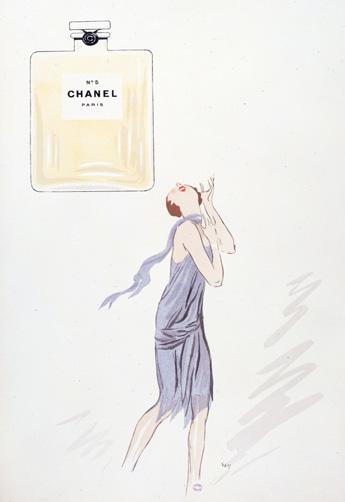
Full details doylecollection. com/hotels/the-kensingtonhotel/package
COUNTDOWN TO JUNE
News & Views
A TALE OF TWO TERRACES
WEEKEND CURATORS
Enabling guests to see Cork through the eyes of some of the county’s most creative minds, we’ve devised Curated Weekends at Cork – a series of weekend discoveries in and around the city. Our first is a collaboration with friend of The River Lee, editor of the CLIMATE supplement for The Sunday Times Ireland and founder of Gaff Interiors and passionate advocate for all things low impact, Jo Linehan. Jo has created a walkable weekend itinerary for a two-night stay (including breakfast and dinner at The River Lee), taking in Nano Nagle Place, The Crawford Art Gallery, fashion store Samui, Vibes & Scribes and the full Blackrock Castle observatory experience. Find out more doylecollection.com/cork
Website doylecollection.com
Instagram @thedoylecollection Facebook TheDoyleCollection
GET IN TOUCH ON THE COVER
Figs by Antoine Lecharny as used on A Sense of the Seasons cocktail menu (p.12)
Slice of the City is published on behalf of The Doyle Collection by Rivington Bye Ltd.
Reproduction without permission is strictly prohibited. All details correct at the time of publication but may change.
For all editorial enquiries: enquire@rivingtonbye.com
The countdown to the opening of The Croke Park’s new destination restaurant, The Hawthorn, is quickening – with the first tables set to be waited in June. The space prizes absolute comfort and laidback luxury, but even with such a glamorous refurb, the food is emphatically the star. Championing all things local – the seafood for which Ireland is globally renowned alongside fine meats and veg that are one short step from farm to fork, all cooked to perfection - the menu offers a modern twist on the classic bistro. Hearty, delicious fare for the discerning, accompanied by an impeccably curated list of fine organic and vegan-friendly wines. Open 5.30-9.30, come join us for dinner, Tuesday to Thursday. doylecollection.com/ hotels/the-croke-park-hotel
There’s simply nothing like a drink and a bite to eat al fresco, especially when you’re on a terrace festooned with blooms sipping bespoke seasonal cocktails. This summer, guests can step out of The Dupont Circle into our whimsical wonderland ‘Dreaming in Color’ (below right). In a kaleidoscope of hues, the floral installation has been conjured by DC’s backdrop queen, Garette Turner, creator in florals and purveyor of good times (and owner of Brightly Ever After). An added dimension comes in the works of fearless juxtaposer of colour, local artist, Maggie O’Neil, scattered throughout the installation. Across the Ocean to County Cork and The River Club (at The River Lee) Terrace (below left) collaborated with Fox Flowers to celebrate the sanctuary nature and green spaces bring to city dwellers with cascades of blue-lilac wisteria, rambling ivy, twisting vines and aromatic lavender, rosemary and jasmine, scenting the air. While the designs couldn’t be more different, both bar teams have created some wonderful cocktails to sip under the blooms with The Dupont Circle donating one dollar for each ordered to Washington Studio School (transforming lives through arts education) and The River Lee passing on a euro (per cocktail) to a local community garden project. theriverclubcork.ie. doylecollection.com/hotels/the-dupont-circle-hotel

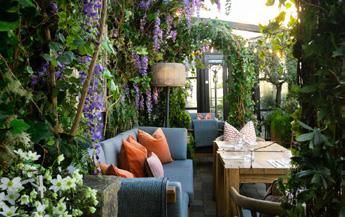 Explore our portfolio of Irish family-owned luxury hotels superbly located in the centre of London, Dublin, Bristol, Washington DC and Cork
Explore our portfolio of Irish family-owned luxury hotels superbly located in the centre of London, Dublin, Bristol, Washington DC and Cork
2 3
THE CROKE PARK
Lithograph of CHANEL No.5 fragrance by Sem, 1924 © Paris Musées, Musée Carnavalet
THE BEES TEAS
Partnering with iconic neighbours, Neal’s Yard Remedies, we meet co-owner Anabel Kindersley



Long-time admirers of the way Neal’s Yard Remedies marries sustainable sourcing and ethical trading with effective, luxurious results, at The Bloomsbury we too are always seeking ways to exceed our environmental targets without negatively impacting the experience for our guests. So, we were delighted to partner together on our Dalloway Terrace summer floral installation and ethically sourced afternoon tea menu. Working closely together with Anabel Kindersley (Neal’s Yard Remedies co-owner) the menu is as kind to the planet as it is delicious for our guests. Our co-branded Afternoon Tea features bee-friendly, ustainably-sourced ingredients (Neal’s Yard Remedies’ Save the Bees campaign launched in 2011), from wild English strawberry and elderflower tartlet to classic scones with jams from Heather Hill’s Farm in Perthshire, and fresh raspberries pollinated by their bees. Organic dark chocolate is sourced from Original Beans, a climate-positive grower that pays pickers properly and invests back in the land. Our drinks partner, The London Essence Company, are offering their range of mixers bursting with beautifully balanced botanicals in delicious seasonal cocktails, and Neal’s Yard Remedies’ own organic rosebuds in their Rose & Jasmine mocktail. While many take their tea traditional, our herbal blend is Neal’s Yard Remedies’ organic Lemon

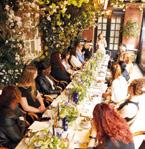
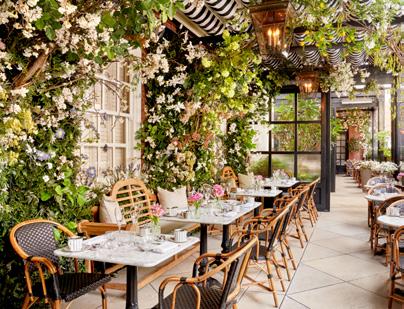
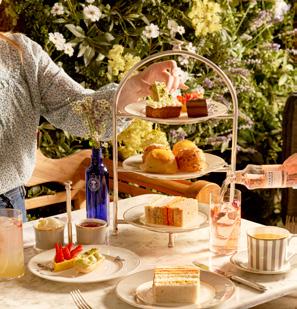
&
Q. What drew you to work with The Bloomsbury?
A. It’s a joy to work with fellow prestigious brands committed to ethical and sustainable practices. The Doyle Collection’s certification in Green Tourism coupled with our consistent score (for nine years) of 100/100 in The Good Shopping Guide’s Ethical Index, exemplifies our shared dedication to responsible business practices.
Q. What did you introduce that made a difference to the menu?
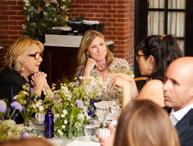
A. For us this menu was about celebrating British produce and transparent ingredient sourcing. We’ve been campaigning to protect biodiversity for years and it was important to highlight why pollinators matter so much – one third of every mouthful of food we eat depends on them. So, we focused on pollinator-friendly ingredients, as well as introducing our organic ‘Biodiversitea’ to the menu, with British-grown lemon balm, elderflower, lime flower, fennel & chamomile.

Q. You’ve campaigned for years to save bees, and on wider environmental issues. What can people do to help?
A. We launched ‘Save the Bees’ in 2011 with our Bee Lovely collection, (donating 3% of all sales to bee-friendly charities) and we’re thrilled that Dalloway Terrace is donating £1 from every afternoon tea to the Bumblebee Conservation Trust. Without pollinators our entire ecosystem would collapse. In 2013, we delivered a petition to 10 Downing Street with 117,000 signatures, which helped ban neonicotinoids. But last year the government lifted the ban on one neonicotinoid (a teaspoon of it can kill 1.25 billion bees). We simply cannot let this pesticide continue to be used in farming, which is why I’m campaigning loudly against it. Since last year, I’ve been busy forming a coalition of over 100 British businesses and organisations, to call on the government for a pesticide reduction strategy that promotes nature-friendly farming practices in the UK. And everyone can do their bit – from pollinator-friendly plants in your garden to window boxes of lavender, scabious or salvia. Or, write to your local MP; simply visit standbybees.co.uk to download a letter template.
Q. In the broader environmental space, what small lifestyle changes can people make?
A. It’s not always possible, but if you can, opt for certified organic food and beauty. Plus, we can all ‘reduce, reuse, recycle’ in every aspect of life. We’ve installed a TerraCycle Zero Waste Box™ in all our stores helping people to correctly dispose of hard-to-recycle packaging components such as pumps and lids - from any beauty
brand. Another easy switch is buying larger refill packs of daily products, which not only saves on plastic, but is purse-friendly, too. For instance, our 950ml eco-format bottles use 57% less plastic compared to the equivalent volume of standard sizes.
Q. You have your eco factory and are certified Carbon Neutral – how do you select your suppliers?
A. From Somerset to France, Madagascar to Oman, we work with a global network of suppliers, some for over 30 years, with relationships built on our commitment to environmental stewardship, social responsibility and quality ingredients. We have worked with many of them to achieve organic certification, supplying the skills and tools they need to uphold certification standards – which is good for their businesses as well as ours. We also fund projects that empower communities, such as rainwater collection tanks for our tea tree oil supplier in Kenya, and we pay a social premium to several suppliers which funds positive initiatives. For example, our social premium has enabled women in our Moroccan Argan Oil cooporative to work across all areas of their business, from transport to administration, in the traditionally male-orientated Berber community.
Q. What’s next for Neal’s Yard Remedies?
A. We have a lot of exciting products in the pipeline. Our aim is to prove organic works – you don’t have to sacrifice ethics or nature for luxurious, effective skincare. We recently launched our certified organic and vegan collection of proven skin Boosters: Hyaluronic Acid, Vitamin C and Rosehip Oil. We also continually review our environmental efforts, and this year removed our outer boxes, saving nearly 4.8 tons of cardboard annually. And last but by no means least, I continue to grow our Stand by Bees Coalition – protecting biodiversity for our future generations together.

4 5
We’ve been campaigning to protect biodiversity for years and it was important to highlight why pollinators matter so much – one third of every mouthful we eat depends on them
Balm
Elderflower Biodiversitea. Our terrace launch was a starry affair, attended by London’s finest and hosted by Anabel, with whom we were delighted to sit down to ask a few questions.
This page The great and the good join Anabel to launch Dalloway Terrace’s Summer Installation. Right Anabel Kindersley, co-owner of Neal’s Yard Remedies.
WOMEN IN THE ARTS
In Ireland today women in the arts are doing things their way, stepping up to take on the top jobs in Irish theatre, and introducing some of the world’s finest minds to each other, and the rest of us
As headline sponsors of Borris House Festival of Writing and Ideas and The Dalkey Book Festival, partners of The Abbey Theatre and owners of both The Bord Gáis Energy Theatre and The Doyle Collection, John and Bernie Gallagher couldn’t be more committed patrons of Ireland’s thriving arts scene.
It’s hard to gauge how many people make a living as artists in Ireland today, but the Musician’s Union has 32,000 members, there are around 5,000 fine artists and, for writers, Ireland ranks #40 in the world, from a population ranked #124. In the USA $1.02tn a year comes from the arts with £10.47bn in the UK. Ireland doesn’t do the same annual calculations but, back in 2009, the arts were estimated to bring in around €5.5bn.
Regardless of numbers, the arts have for centuries been Ireland’s calling card. To
mark International Women’s Day, 2023, the Irish Times rounded up 70 women ‘who’ve shaped Irish culture’ and the stellar list tells a tale of giants.
Poets spanning Eibhlín Dubh Ní Chonaill (whose 18th century Lament for Art Ó Laoghaire, found its unlikely way into Hunter S Thompson’s Rum Diary) to 26-year-old Nigerian Irish poet, Felixia Olusanya (Felispeaks), the majestic Edna O’Brien (who started out on the receiving end of some bruising misogyny), to the sensational Sally Rooney, set to dominate a more equitable era.
While Irish female-authored movies have been showcased at some of the world’s best-known film festivals, Toronto, Sundance, Cannes and Dublin, (including Nathalie Biancheri’s Wolf, Cathy Brady’s Wildfire, Claire Dunne’s Herself and Ailbhe Keogan’s Sidelined, to name a few), progress for women in film
has required input from Screen Ireland POVs scheme.
The idea, to support projects already in development with an additional mix of modest finance and expert mentorship, has seen a strong increase in numbers – in 2015 just 10% of directors and 27% of writers in Ireland were women but by 2020 numbers had risen to 34% female directors and 47% writers.
By contrast, root and branch change in Irish theatre came in with a bang, triggered by the launch of a Season at The Abbey (Ireland’s National Theatre) entitled ‘Waking the Nation’, commemorating 100 years since The Easter Rising (1916). Featuring works by nine men but just
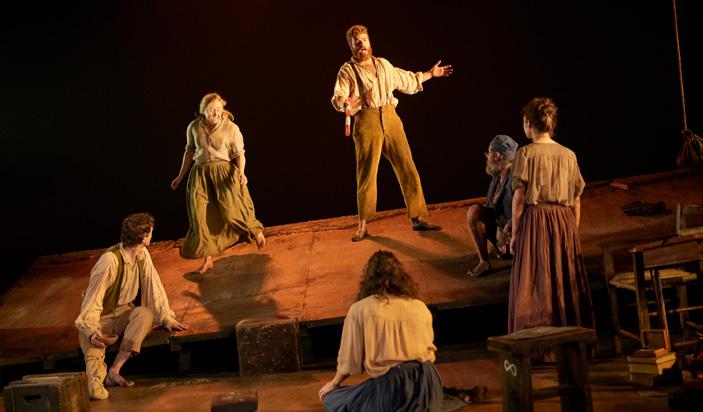

one woman, with eight male and only two female directors, social media had plenty to say on the subject, coining the ironic hashtag #WakingTheFeminists and spawning lasting change.
Theatre’s glass ceiling had recently been shattered in Britain, (where in 2012 Josie Rourke became Artistic Director at The Donmar, in 2013 Vicky Featherstone led the Royal Court and in 2014 Erica Whyman took on the RSC), but in 2016 no major Irish theatre had a female Artistic Director and they had overlooked female storytellers too. For many women that left no choice but to create their own opportunities via players and companies rather than spaces and places.
Annie Ryan founded The Corn Exchange Theatre Company in 1995 and still leads. Lynne Parker co-founded Rough Magic back in 1984 and will enter their 40th anniversary year as Artistic Director. Pan Pan was founded in 1993 by co-artistic directors Aedín Cosgrove and Gavin Quinn, who have created 43 new plays and performance pieces and in 2009 Vanessa Fielding founded multi-disciplinary arts space, The Complex.
Following 2016’s outcry, change in the establishment began with the appointment
As part of 2015’s ‘Waking the Feminists’ event, organisers selected thirty women in Irish theatre and gave them 90 seconds each to articulate what needed to change.
of Selina Cartmell as Artistic Director of The Gate in 2017, followed by Róisin McBrinn in 2019. The Abbey Theatre has also embraced change. As part of 2015’s ‘Waking the Feminists’ event, organisers selected thirty women in Irish theatre and gave them 90 seconds each to articulate what needed to change. It’s not long, but as Caitriona McLaughlin pithily observed; “When something is pressing, urgent, necessary, of course it can be said in 90 seconds; in fact, it can be spoken in three: ‘Notice’ and ‘choose better’ “. The Abbey listened.

CAITRIONA MCLAUGHLIN, THE ABBEY THEATRE
Today Caitriona is in her second full season as Artistic Director of The Abbey Theatre. The role was advertised in 2019 and she applied, interviewed and was duly appointed. A North Donegal native, Caitriona always had a passion for poetry. Her shyness meant “performing someone else’s words gave me something to say”, which sowed an early desire to act. But
real life and a university place to study science got in the way. Despite having “my mind blown by a production of Carmen when I was at university, I didn’t have the connections, I hadn’t been to Trinity and I had no family in the theatre, so it just seemed impossible”.
Catriona’s route into theatre was entirely unconventional. While working as a sewage analyst, having taken an acting workshop and been offered a full-time microbiology position she decided to quit her job and take an internship at the Playhouse Theatre Derry where she was mentored by Sinead Devine (“she changed my life”), running workshops for young people traumatised by the conflict, for prisoners and even for stroke victims “exploring fear, tension and conflict in their bodies”.
Caitriona’s first paid directing gig was at London’s New End Theatre (Modern Man by Patrick McCabe) where she proved she really could tell a story. Teeth were duly cut as Associate Director at Battersea Arts Centre, with a spell at the Finborough
6 7
Top Left Caitriona McLaughlin and Top Right her award winning production of On Raferty’s Hill and Right Citysong by Ros Kavanagh at Dublin’s Abbey Theatre.
Theatre and Theatre Peckham before, in 2007, Caitriona won the prestigious Clore Scholarship. This gave her nine months at London’s Royal Court Theatre, and four weeks at Philip Seymour Hoffman’s Labyrinth Theatre for their Summer Scape programme. “The company brought together established performers and storytellers with young actors, writers, stage managers and everybody worked in every discipline, so actors would write and writers would act. We’d read 40 new plays and rehearse four a night, always learning, developing and creating. It was an unbelievable experience.”
A decade on, via off Broadway (Rattlestick Theatre), Derry’s 2013 City of Culture Festival, Creative Shops and Opera (Wexford, later Irish National), Caitriona wended her way back to Dublin where, in 2017 (for The Abbey Theatre) she directed Marina Carr’s play, On Raferty’s Hill, and was awarded Best Director at the Irish Times Theatre Awards.

Today, Caitriona is itching to take on Marina Carr’s The Boy, an “epic approach to the Theban Trilogy. I love Greek Plays anyway, but Marina finds something so original in these plays, they feel epic,

unruly and powerful and make us think about the vast complexity of the universe”. Coming full circle, this brings a 2015 keynote speech Caitriona delivered to mind. “You choose to be equal. It is not bestowed on you….none of us any longer have to wait for equality. But, and this is a big but: you do have to embody it to expect it.”
The Abbey Theatre abbeytheatre.ie
SIAN SMYTH, THE DALKEY BOOK FESTIVAL


Shaping your own destiny is the sentiment squarely behind the origin story of The
Dalkey Book Festival. Originally a kitchen table affair, now run by a team of 50-60, in 2022 welcoming over 19,000 people, Dalkey was founded by book lover (and recovering lawyer) Sian Smyth and her husband, the writer David McWilliams. We spoke to Sian.

“In early 2010 the recession had hit really hard – Dalkey was decimated, 18 businesses had closed and businesspeople called meetings to see what could be done. David wrote an article saying people couldn’t complain about not having a butcher if they shopped in the out-of-town supermarket. But then we thought, what were we going to do?”
“We focused on what makes Dalkey special. James Joyce taught in a Dalkey school, Maeve Binchy lives here, George Bernard Shaw spent his summer holidays locally, Sebastian Barry went to school
“It’s a beautiful place, it’s beside the sea, it’s close to the city, it’s got a literary history, I love books. Let’s do a book festival! And that was it.”
here, Samuel Beckett and Flann O’Brien were always around town. It’s a beautiful place, it’s beside the sea, it’s close to the city, it’s got a literary history, I love books. Let’s do a book festival! And that was it.”
David knew Joseph O’Connor and rang him to ask if he would take part, and ask two more writers? Sian targeted Maeve Binchy. “We didn’t know her but we found out how to get in touch. And she said ‘We should’ve done this years ago. Of course, I will help and get two writers’. So, we had six writers, we decided to do it in June, and off we went.”
“I had zero experience but I’d recently quit my job as a banking lawyer so the one thing I did have was time. We knew someone who ran festivals, he gave me a crash course in how, and it has grown organically year on year. Every event is ticketed, in every venue in town and visitors spend six times their ticket price(s) putting money into the local economy.”
Today The Dalkey Book Festival has a life of its own. “Most of my team are from a film or TV background and we have an amazing producer and box office manager.
Money was tight at the beginning – we could only grow it because people come – but we have also found great sponsors, which enables us to get such amazing people. We can fly them over, put them up in a nice hotel, and look after them properly. That’s very important when you’re targeting the kind of people we are.”
Completely trumping Dalkey’s pictureperfect setting is the roster of speakers Sian draws to this little town, down the coast from Dublin, every year. In 2023, sessions open with an international panel discussing the world today at a tipping point and closes in Dalkey Church with Bono and Fintan O’Toole chewing the fat.
Between the two a stellar roster of poets, authors, journalists, economists, politicians, broadcasters, academics and musicians, featuring, among many others, Dylan Moran, Ruby Wax with neuroscientist Ian Robertson, Alice Ryan with Madeline Kean, The Edge with Professor Brian Cox, Roddy Doyle with Donal Fallon, and many more. “Oh, and we’ve got Tom Hanks sitting down with Andrea Catherwood to discuss his debut novel. His publisher sent it to me, I read it
8 9
Far Left Vanessa Fielding who struggled for 15 years to get her new, multidisciplinary venue The Complex off the ground directs Denise McCormack, Left in her own “translation” of Tennessee Williams’ The Rose Tattoo. Top left Róisín McBrinn, who was nominated for Best Director for her production of Roddy Doyle’s The Snapper, at Dublin’s Gate Theatre. Above Sian Smyth, director of Dalkey Book Festival flanked by Seamus Heaney and Bono.
immediately then found some connections to Maeve Binchy so I was able to write an invitation that was more meaningful –and he responded. I wanted him to talk to an Irish woman, with reach, a consummate professional – and she had to be funny.
So, Andrea Catherwood was the obvious choice. After Tom’s audience with just 400 people he’ll be signing copies in the independent Gutter Bookshop, which came as a pop-up in 2013 and never left.”
“The truth is that with people like that I’m only going to get them if I can make them think it’s going to be fun – or they’ll be part of something or meet someone. And that’s why they come back year on year.”
Dalkey Book Festival, 15-18 June dalkeybookfestival.org
VIV GUINNESS, BORRIS HOUSE FESTIVAL OF WRITING AND IDEAS
The magical, convivial spirit that brings serial regulars back every year, is a factor Viv Guinness, co-founder and curator of The Borris House Festival of Writing and Ideas depends upon.

“Even though we get some extraordinary people, the house itself adds a special extra dimension. We encourage all speakers to stay for the weekend if they can, and there’s a feeling of safety and security within the Borris House grounds that makes everybody relaxed and comfortable.”
Everything is choreographed and planned so that “when people speak it’s like friends conversing. We approach the event like a weekend party - spending time together, making friends, having a wonderful experience – exchanging conversations and sharing ideas. The music is a wonderful addition to the mix – Hugo (Jellett, Viv’s co-founder and festival producer) also runs Electric Picnic so he brings a wonderful network of musicians.”
Performances are memorable – where else would you get to see Lemn Sissay (who had come to do his talk with Emma Kirwan) improvising for an hour with I Have a Tribe (aka Patrick O’Laoghaire) having never met before? Or Jeremy Irons and Sinéad Cusack performing The Wasteland together?
“It all started because I work with Lilliput Press (a publishing house in Dublin) and was attending the Hay Festival where I met founder, Peter Florence, shared our idea to start something and he just said, ‘do it!’. Hugo had recently started the Carlow Arts Festival and was interested, so off we went.”
“From the start we wanted it to be much more than authors promoting their latest book so we focused on bringing people from many backgrounds together all in the service of conversations, performance and ideas. Starting with our own network.”
“I was already lucky enough to have in my life wonderful people like Anne Enright, Coim Toibin, Lenny Abrahamson, Catherine Heaney, William Dalrymple, Stephen Frears, David Puttnam and Fintan O’Toole (who is the most incredible supporter for us)”.
“In the first year my good friend Alexandra Pringle (Virago Director and Editor in Chief at Bloomsbury) introduced me to Margaret Attwood at the Jaipur Literature
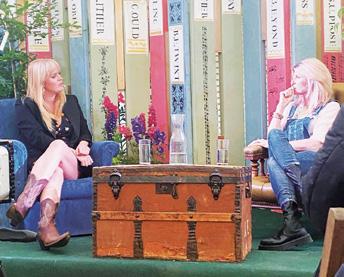

Festival, and she agreed to speak in 2018. Alexandra also knew Donna Tartt, who made a rare public appearance for us.”
“Our first year featured twenty writers, including Ian McEwan, who was one of the festival’s biggest early cheerleaders. It wasn’t long before we had artists like Laurie Anderson wandering through the crowds chatting to festival goers, and Dave Gilmour stepping in at the last-minute to fill a slot.

“For 2023, I’m really looking forward to Sinead and Jeremy reading Ulysses, and climate activist Mikaela Loach speaking
to David Puttnam. We were thrilled to get neuroscientist Ian McGilchrist talking AI with QI’s John Lloyd and All Souls Fellow, Katherine Rundell. Also Eoghan Dolton, who has created his own Irish rainforest, with Paul McMahon, who wrote Island of Woods; that will be quite a debate. Jason McCue (human rights lawyer) is bringing legal action against the Wagner Militia and discussing it with Carole Cadwalladr.”
“Next year we’re hoping Margaret Attwood will be back. I would love to have Sally Rooney, Louise Kennedy, Merlin Sheldrake, Chimanada Ngozie Adichie,
Louis Theroux and Isabelle Allende. But the one person I ask to come every year without fail is Kate Bush. I shan’t give up.”
“We have two wonderful board members, Rita Doyle and Kathy Gilfillan, who have brought in some marvellous patrons. The Arts Council were amazing of course, during Covid, and John and Bernie Gallagher are such a continuing support to us. They attend every year, too, and they really understand what we’re trying to achieve here.”
The Borris House Festival of Writing and Ideas, 16-18 June 2023 festivalofwritingandideas.com
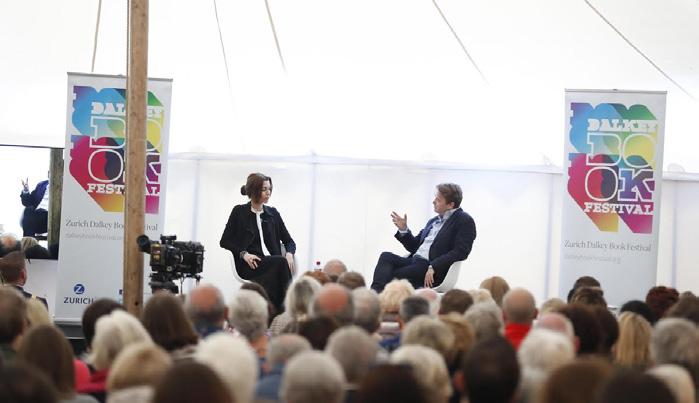
10 11
Where else would you get to see Lemn Sissay (who had come to do his talk with Emma Kirwan) improvising for an hour with I Have a Tribe...?
Above Cameras roll at The Dalkey Book festival. Top right Vivienne Guinness founder of The Festival of writing and Ideas at Borris House, Carlow. Right Both Borris House and Dalkey festivals attract some of the biggest literary names in the world.
SPIRIT OF THE SEASONS
When you’re marrying dreamy nostalgia with some wonderfully inventive cocktails, it takes an exceptional artist to capture the slices of life that will evoke the spirit of the seasons

When we create a new cocktail menu we start with a concept from which our bar teams dream up a cocktail list (featuring originals and twists on classics), which we then visualise in the menu itself. For The Cocktail Bar (at The Marylebone) we went back to its original concept, which is zoned by season (winter, the lounge area by the fireplace, summer on the terrace, and so on). To really inspire we focused not on the obvious, but that nostalgia the seasons can bring – shards of sunshine that can spirit you back to a moment on holiday – and the bar team worked their magic.
Director of Food & Beverage, Andrea Signanini told us, “we’re a team of five from different places so the seasons mean different things to each of us, and we wanted the cocktails to be personal and nostalgic. From evocative smoke bubbles in The Athlete to truffle oil infused cognac (in The Offering) we’ve created some theatre and magic. And personal touches include La Diablesse, which captures a trip to the Caribbean, while Roman Nightcap was created for a competition held one summer evening in front of the Colosseum. My personal favourite – I’m a whisky man – is the Bourbon meets malt of the Derby Hat.” Once the team’s alchemy was complete we searched for the right artist to bring it to life.
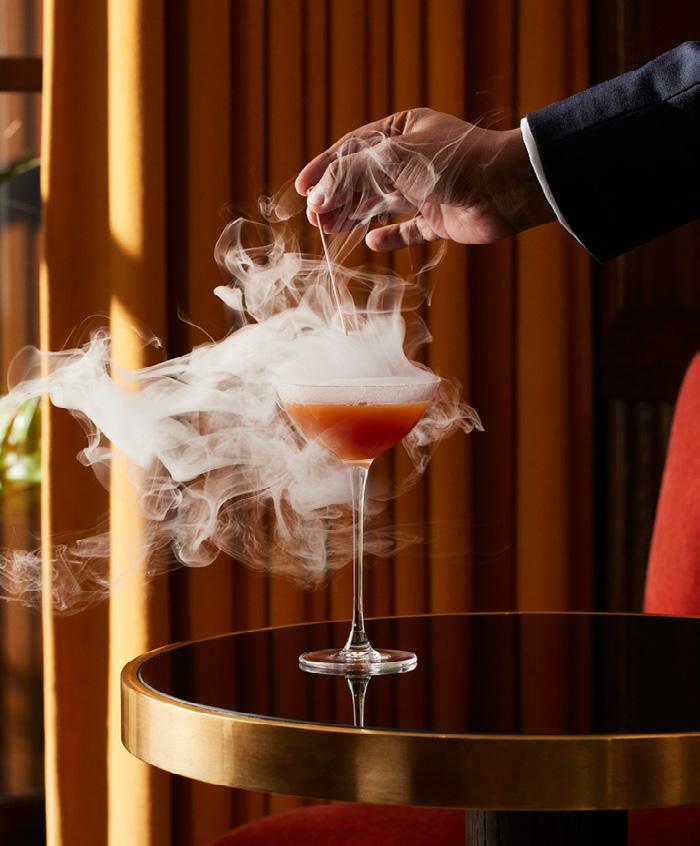
Each image is like a snapshot from childhood, a shard of memory and testament to an artist about whom most in the industry simply say, watch this space.
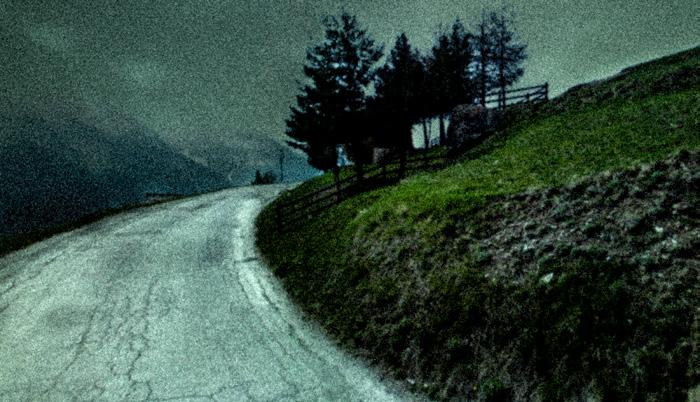

14 15
Left The Athlete cocktail designed to kickstart an evening. Previous page and Above A sense of Autumn and Winter captured by photographer Antoine Lecharny ( Right). Overleaf The Selkie cocktail and The Marylebone bar which is imbued with each season.
Antoine Lecharny is a photographer, visual artist and evocateur born in France almost indecently recently for the volume of his output - in 1995. His creative spirit has ensured every moment of that time was spent wisely, starting with a trip to Transylvannia to photograph the lives of Roma families (winning the Paris Match Grand Prize for student photojournalism) and into a residency for the Festival Planches Contact, where he captured, in Côté Fenêtre, the essence of train trips between Paris and Deauville (winning a Jury Prize along the way). The Boutographies Festival’s Public Prize for his series Même pas morts followed shortly afterwards.

On the side, Antoine has been drawing and sculpting for years, launching Abstract Design with Henri Frachon, for which he received the Audi Talents 2020 award. All making him the perfect photographer to illustrate our A Sense of the Seasons Cocktail menu.


Our process was iterative, with the team at The Cocktail Bar at The Marylebone sharing cocktail ideas and ingredients, the stories and spirit behind them and receiving images that Antoine felt captured the essence of each - soft, moody, nostalgic. Each image is like a snapshot from childhood, a shard of memory and testament to an artist about whom most in the industry simply say, watch this space.
doylecollection.com/hotels/the-marylebone-hotel
16 17
“We’re a team of five from different places so the seasons mean different things to each of us, and we wanted the cocktails to be personal and nostalgic.”
SEE & BE SEEN
From country seats to city manners, we look at the history and the evolution of the ‘London Season’, one-time marriage market and social whirl for the landed gentry…
Once upon a time, many years ago, Britain was governed entirely by aristocrats – those born to established landowning families, generally titled, and frequently related to the nation’s premier family, the Royals.
As early as the days of Elizabeth I, the young ladies of these noble born families were brought to court and presented, mostly so the Queen could pick her roster of ladies in waiting, replacing those that had inconvenienced her by marrying a fine nobleman before being whisked away to adorn his country estate or occasionally to his apartments in court where she would thereafter be managing a retinue of staff, confined by birth after birth and mostly answerable to her lord and master. Given that most landed families lived in their country estates, apart from their ‘nearest neighbours’ (generally the
principal inhabitants of the nearest sizeable village, often miles away) and family, children of the aristocracy grew up secluded at home, taught by tutors and nurtured by staff.
While parents of the aristocracy and gentry were famously not hands on with their offspring (delegating that role to a retinue of nannies, governesses and tutors), they nonetheless had high expectations of their progeny fulfilling a clear role in ensuring family legacy, power and the wealth that they aimed to grow with every generation.
The season started with a fairly practical purpose, to build alliances with other powerful families; as well as staying firmly on the right side of the King or Queen of their day – which had been no easy feat in tumultuous Tudor and Stuart times, where power ricocheted around, religion meant

everything, the great families endlessly schemed and jockeyed for position and a simple twist of fate could see reputations tumble and heads roll.
The Orange and Hanoverian dynasties, not great embracers of drama, ushered in an era of relative calm, life for the aristocracy became a little less high stakes and, while new favourites were made and, naturally, some of the grandest families found themselves less in favour at court, the simplest way to shore up certainty and preserve power remained in building alliances with the other great families primarily through marriage. And if young men and women were to marry, they must, of course, meet.
The London season took shape during the Regency period, which heralded an era of new freedoms and considerable decadence
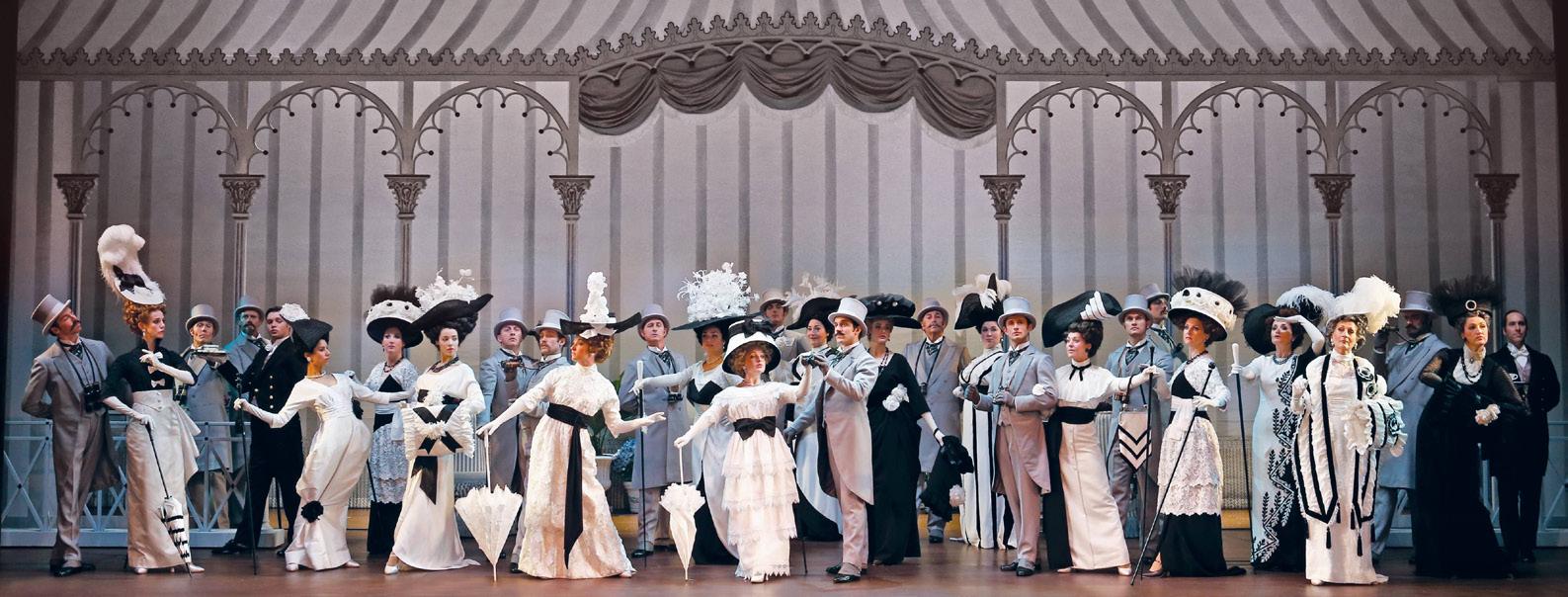
18 19
ASCOT SCENE, MY FAIR LADY, REGENT’S THEATRE, MELBOURNE 2017
in royal circles, led by the lotus-eating Prince Regent (later George IV), and the indulgence of his court – and it was during this period that the pattern of the season became more established, too.
At first, the dates of the season followed those of Parliament. Aristocrats might run their local county like a fiefdom, but real power lay in Westminster and the Royal Courts, and so it was to London, following long, wet, dull winters in the countryside, that aristocrats and gentry alike would sally, to spend some of the balmier months in the capital, always returning to their estates for the Glorious 12th (August, the start of the shooting season).
young ladies and gentlemen rode, strode and gossiped the days, and danced the nights away
For those with offspring of marriageable age, town houses would be opened-up, or taken, and many a varnished wooden trunk packed with frothy confections of organza or chiffon, or smart morning dress, would sway atop carriage and chaise as entire families would up sticks and come to enjoy the delights of ‘town’.
As the Hanoverians popped off one George after another (though the last of this dynasty was admittedly a William – the Fourth) and Britain embraced an extended period of expansion (empire, mainly), innovation (the industrial revolution) and stability (Queen Victoria was on the throne for almost 64 years you know), the season opened up to the most successful industrialists, wealthy Americans and some families from the colonies, too.
In the 19th century, the new class of exceedingly wealthy industrialists often had social ambitions, intent on marrying into the ‘very best’ families. Actually, this change was rather handy for the landed gentry, even those whose fortunes were commercially made. For generations inheritance was via primogeniture (the entire estate inherited by the eldest son). While this kept the great estates intact, it left many a younger son for families to find employment, not to mention daughters.
While daughters often required large dowries, or great beauty, this new social development made alliances that not long before would have been considered beneath aristocrats welcome and necessary. At its height, the season featured around 10,000 of the country’s well born and wealthiest, as they engaged in three months or so of fun and games, morning, noon and night. While the young ladies and gentlemen rode, strode and gossiped the days, and danced the nights away, it was the chaperones for whom the test of stamina was greatest. Keeping a young lady or several under observation while they danced for hours, sitting stiffly in an upright chair struggling not to nod off was their lot evening after evening, yet mothers and aunts put comfort to one side and stuck it out hoping a proposal would be the reward, rather than a second, or for the dedicated party-goer even a third season.
Mornings were dedicated to walking, riding, errands, admin (so many ‘thank you’ notes), visiting or receiving friends (only the close ones before lunch) and perhaps taking in an exhibition. Afternoons were a little more formal – generally consisting of lunches, afternoon teas, concerts and charity events.
A little light dinner preceded evening trips to the theatre and opera, and to smaller, private parties and soirees. These were followed at 11ish by a (usually) private ball or formal dance in London mansion or palace, from which carriages were often not called until 3am. While for young people, the real highlight would likely be the dances and balls, girls (and, actually, young women recently married into the landed classes) were only considered truly ‘out’ when they had been presented to the King or Queen of their day. This was a tradition inaugurated by George III in 1780 in celebration of his wife, Queen Charlotte’s birthday, at a ball named after her. The Queen Charlotte’s Ball continued to be the pivotal event punctuating The
Season for close to two centuries. At the first ball debutantes were presented to the Queen as she stood beside a gigantic birthday cake, her crinolined skirts forming a pleasing symmetry with the lower, larger layers of the frosted white cake. The elaborate curtsey they were required to perform had to be learnt (often at finishing schools or in private lessons with courtiers) and the white dresses they wore (as many as six changes per day) were subject to strict codes that varied very little between then and the final presentation in 1958.
It was an arduous day for debutants and royals alike. The Mall would be entirely gridlocked by carriages during the Victorian era and the hours of waiting around to perform a single elaborate curtsey was not universally considered worth the time involved even by the debs and their delights.
By the 20th century, a royal mutiny was on the cards. In 1936, Edward VIII ran out of patience halfway through the hours-long ceremony and exited the palace for a round of golf leaving an aide to announce that anyone he had not yet seen could “consider themselves presented”. One can only imagine the quiet storm of gossip and griping, after all the expense of the court dresses, the hair, the make-up, the transport and the waiting.
The famously outspoken Prince Philip, when faced with a six-foot birthday cake and an endless queue of genuflecting girls in white evening dress invading his home, called the whole charade “bloody daft”, while Princess Margaret decried the increasing influx of the moneyed classes by rather charmlessly declaring, “we had to put a stop to it – every tart in London was getting in”. Put a stop to it they did, though the ball limped on and the season itself continued to evolve into something that spanned ancient history and modern life quite nicely.
Queen Charlotte’s Ball has recently been resuscitated for the 21st century by former debutante, Jenny Hallam-Peel, shifting in focus from making an entry into high society and finding the right kind of spouse

to “teaching business skills, networking, etiquette and fundraising for charities”. Young women from all over the world apply for a ticket to be dressed by Harrods, wined and dined at a sponsors table, curtsey to the enormous cake and dance the night away with an assembly of ‘debs delights’.
Today’s ‘Season’ is composed of public events all over London – though tickets may play hard to get. While you won’t get to curtsey to His Maj beside by a giant frosted cake, and while you won’t have to wear a floaty white dress with a precisely measured train, very specific sleeves and a veil, there are still some, shall we say, eccentricities it’s worth getting on top of.
Many events in the season come with a dress code - notably Ascot’s Royal Enclosure. Men must wear morning dress, including actual top hats, and ladies should choose dresses of modest length (with strapless, off the shoulder, halter necks, spaghetti or sheer straps and sleeves not permitted), compulsory hats (no fascinators) and headpieces only if they have a solid 4-inch base, though both can wear national dress (for which hat rules are waived if the dress doesn’t include one), or certain military uniforms.
In addition, there are odd traditions which it’s worth knowing about. Generally, it is considered unwise to wear heels at turfed events – at Wimbledon if you walked on the hallowed grass in vertiginous heels, you’d be given the heave-ho, sharpish. Yet, at a polo ground different rules apply. Horseshoes naturally kick up the turf, so periodically the umpire blows a whistle, riders repair to their grooms and spectators, dressed up and often half cut, clamber over picket fences and swarm onto the pitch, where they smooth and stamp the surface flat, high heels or no. It’s called Divot Stomping. Of course it is.







If you can navigate the social mores, traditions and codes of dress, the season will likely reward with sightings of many a crowned head, Lord and Lady, A-lister, movie star and minor royal, usually lurking behind fabulous sunglasses or under a fancy hat…
THE SEASON
According to Tatler, bible of all things smart, the modern Season starts in March with the Cheltenham Festival, unfolds via Chelsea Flower Show and Royal Ascot, closes in September with the Goodwood Revival, and is quite the social whirl. By the time this issue comes out (in June) you’ll have missed the boat on a couple of titans of the early season. We’re talking Cheltenham and Chelsea – so make a note and don’t miss them in 2024…Aside from that, we’re delighted to present the SOTC summer picks from The London Season 2023. Every ticket is a hot one, so do book early to avoid FOMO. And actual MO of course. Nobody wants that.
CHELTENHAM FESTIVAL, 12th - 15th March 2024 thejockeyclub.co.uk/cheltenham/events-tickets/the-festival
Drawing a daily average of 65,000 to experience some of the best steeplechase racing in the world, Cheltenham might not come at the warmest time of the year, but it signifies the end of winter and there’s a giddiness that’s palpable even among the more serious racegoers. There’s the usual mix of dining (though picnicking, not so much), fine wines and dressing up – with Champion’s Day, Ladies’ Day, St Patrick’s Day and Gold Cup Day drawing visitors in vast numbers to bypass the regency splendour of the fine Gloucestershire town of Cheltenham, arriving at the stadium to be swiftly shuttle bussed to the racecourse.
RHS CHELSEA FLOWER SHOW, DATE TBC, MAY 2024 rhs.org.uk/shows-events/rhs-chelsea-flower-show
Colossus of the global garden design schedule, Chelsea Flower Show has pioneered the possible in garden design for well over a century, drawing the world’s greatest designers and gardeners in towering displays of artistry and ingenuity to be enjoyed by crowned heads, old families, movers, shakers, celebrities and garden lovers from all over the world. Held in May at the Royal Hospital, Chelsea, the flower show is open to all, but RHS members get serious perks (including dedicated days) as well as cheaper ticket prices, so it’s worth looking into membership..
21 20
YOUR GUIDE TO
glyndebourne.com












When 19th May – 27th August
Where Near Lewes, East Sussex. One hour from London by train, plus a short transfer by coach from station to Glynde
What As the founder used to say, Glyndebourne began with a love story – and, as one of the world’s most celebrated opera houses, it’s born to tell them. The original love story went thus. John Christie, owner of Glyndebourne House, originally a 17th century manor extensively renovated in the Jacobean style, was a passionate music lover (to the extent that he had added a 24m room to his house and within it commissioned one of Britain’s largest church organs). But it was to one of his popular amateur opera evenings, in 1931, that he had invited Canadian soprano, Audrey Mildmay, with whom he fell madly in love. They married months later and, by 1934, had built and opened a 300-seater auditorium for opera, which they refurbished several times and which, by 1977, sat 850 people, complete with rehearsal rooms. Under the stewardship of John and Audrey’s son, Sir George Christie, and his son Gus, a new theatre was built in the 1990s, treating 1200 to its wonderful acoustics. Set in the rolling South Downs, near the town of Lewes, Glyndebourne is almost as well known for its fancy picnics with fine wines, champagnes and on occasions butlers, as well as its excellent restaurant. On sunny afternoons there are few better places to see, be seen and treat your ears to world-class opera.
Who Everybody who is anybody goes to Glyndebourne.
Wear Dress up. Officially it’s black tie – so, gowns and dinner jackets. However, cocktail dresses and suits are fine for women, while men simply need to look smart. If you did rock up in jeans and flip flops, you’d not be sent home but a little chorus of tuts might be audible.
EPSOM DERBY thejockeyclub.co.uk/epsom-derby
When 2nd June (Ladies’ Day) – 3rd June (Derby Day)
Where Epsom Downs Racecourse, Epsom, Surrey. There are transport options aplenty

What Derby Day at the Epsom Downs racecourse is Britain’s richest flat (no fences) horse race and attracts some of the biggest crowds on earth. Originating in 1780, ‘The Derby’ as it was simply known, became an enormous draw in the 19th century, when it was run midweek, pulling in huge crowds to enjoy the racing, circus performers, jugglers, a steam fair and all sorts of shenanigans; regularly attracting chroniclers of the day, such as one Charles Dickens. Today, Ladies’ Day brings in huge crowds of the glamorously dressed (as well as photographers from mailonline to chronicle anybody a little the worse for wear taking an unscheduled lie down). There are many ways to see the races, which, apologies, ladies, are still the star of the show – you can choose from the Grandstand, the Queen Elizabeth II Stand, the vantage point on Tattenham Corner, or Lonsdale on the other side of the course. Those with kids can enjoy the Family Festival, too. Picnicking packages are available. Check it all out online and book to suit your group.
Who Honestly, the world and his wife, from soap stars to Royals.
Wear In general enclosures the dress code is come “dressed to feel your best”, generally interpreted as smart casual, jumpsuits and dresses, sometimes with hats, with men in light suits. The QEII Stand operates a formal dress code – morning dress. Check the website and dress accordingly.
CHESTERTONS POLO IN THE PARK polointheparklondon.com

When 10th - 12th June
Where Hurlingham Park, London SW6
What: Nothing says ‘The Season’ like a few fast and furious chukkers (periods of play, each 7.5 minutes’ long, a match is four to six, of polo) and Polo in the Park is the most fabulous location. Tucked in a smart suburb of mansion blocks behind Putney Bridge station, Hurlingham Park and the renowned private members’ Hurlingham Club (where Kate Middleton takes tennis lessons and aristos play hard fought games of croquet on manicured lawns) are an oasis of class right beside the river. The perfect place for a three-day celebration of the straining of saddle and sinew in quest of a win. For the English upper classes, everything is improved by simply adding a horse, and polo itself comes across like hockey on horseback, but its origins might surprise – it’s the world’s oldest team sport, with its first recorded tournament back in 600BC, played between the ‘Turkomans’ and the Persians. With its bursts of speed and demands of balance, polo was widely adopted to train cavalrymen for war. And it really is the most thrilling sport to watch. Plus, there’s dining (street food, too), fine wining, a festival atmosphere and pitch side parties. Get tickets. Go!
Who Polo is always a draw and any club that boasts the future Queen as a member will be packed to the gunwales with debs’ delights.



Wear There’s no dress code, and it’s outside, so rain has been known – however, generally people dress for a garden party.

ROYAL ACADEMY SUMMER EXHIBITION royalacademy.org.uk

When 13th June - 20th August
Where Burlington House, Piccadilly, London W1
What The Royal Academy was founded in 1768 with a view to establishing an open exhibition for artists of all abilities to enter, from which the very best would be selected and shown in the grand galleries of the academy. The Royal part was granted by George III after a visit from a group of artists petitioning his permission to set up a society for art and design, a school and the open exhibition. Today, the Summer Exhibition is the world’s oldest submission show with over 10,000 entries from around 5,000 artists from which 1,000 pieces are selected for display. The exhibition is curated each year by Royal Academicians (RAs) with a wellknown co-ordinator/lead, recent examples being Grayson Perry and Jock McFayden, and is absolutely one of the high points on the cultural calendar. Each piece goes through a rigorous selection process and the resulting exhibition mixes new works from high profile RAs such as David Hockney and Tracey Emin, alongside prints, sculptures, photographs and paintings from keen amateurs all over the British Isles. Most pieces are for sale.
Who It’s one of the hottest tickets in the capital and a wonderful exhibition to wanderthere are always interesting people at the Royal Academy anyway but on previews and at private views you’ll join artists and collectors rubbing shoulders with celebs, connoisseurs and members of the Royal Academy. Become a friend and you qualify for private views – as well as supporting the arts.
Wear If you’re going to a PV and you fancy dressing up, why not? Anything goes here. Country friends often still wear tweeds and headpieces. It’s fun.
22 23
ARTIST DEBBIE LAWSON, 3 D PERSIAN ORIENTAL CARPET SCULPTURE, ROYAL ACADEMY
ascot.com









When 20th - 24th June
Where Ascot Racecourse, Berkshire, adjacent to Windsor Great Park
What Royal Ascot is a British social institution. It’s one of the few places where the public really can breathe the same air as royalty, aristocrats, celebrities and so on, all dressed up to the absolute nines tucking into some of the finest dining and bubbles, gourmet picnics and afternoon teas to be found in such proximity to a racecourse anywhere else on earth. And, ah yes, the racing. Between choosing your destination - Queen Anne, the Windsor or the Village Enclosures - unless you’re lucky enough to get a pass to the invitation-only Royal Enclosure, selecting an outfit that’s fabulous enough for such an event (as well as abiding by the rather complicated dress code of your chosen enclosure) and the general excitement of watching the Royal procession on day one, it’s easy to forget the racing, but it really is among the finest you’ll see anywhere. Tuesday is the best day for that, Thursday is the celebration of towering millinery and fabulous frocks otherwise known as Lady’s Day. Our best advice is to plan carefully so you miss nothing and abide by the dress code, or you’ll be sent home for an early bath.
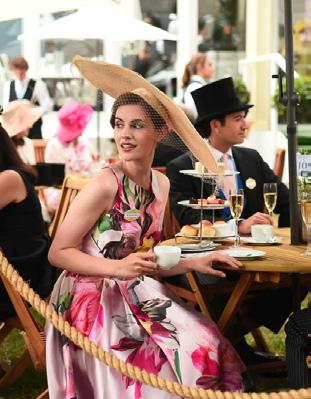
Who The Royal family are out in full force at Ascot, while Lady’s Day is the must visit of the season – it’s a rubbernecker’s dream.
Wear From skirt length to depth of hat brim, necklines (they really hate the Bardot!) to sleeves, the rules are pretty rigorous for women. For men, less so, but still particular. But if you’re going, check – as they’re rigorously enforced.
QUEEN’S CLUB CHAMPIONSHIPS queensclub.co.uk
When 19th - 25th June
Where West Kensington, London W14
What When you describe Queens as the Wimbledon warm up you really are selling this wonderful tournament short. Yet the opportunity to play competitively on the same kind of grass, just before the historic Grand Slam is what brings so many star players to the beautifully kept courts tucked away in residential west London. Wimbledon might be the jewel in the ATP crown, but the cinch championships at Queen’s Club offer a wonderful opportunity to watch world-class tennis in comfort and relative calm. While the Queen’s Club today has the unmistakeable visual cues of a smart, establishment members racquet club, it was built in 1886 as the ‘world’s first multipurpose sports complex’. For many years a well-kept secret, Queens is pretty popular now and tickets are sought after, it’s still easier to get in than Wimbledon and for many it offers much of the spectacle with less of the hullabaloo.
Who There’s an informal spirit to Queens and you’re closer to the big players than at Wimbledon.

Wear No formal dress code but most people make an effort.
Right The Tennis Championships at The All-England Lawn Tennis Club, Wimbledon. While you might secure tickets to Queen’s, tickets to the Wimbledon ‘Finals’ are like gold.

24
hrr.co.uk















When 27th June – 2nd July
Where Henley-on-Thames, Oxfordshire
What For all those people who titter at Brits only being good at sports you sit down for (rowing, sailing and cycling, primarily) Henley is the perfect opportunity to show that sitting doesn’t mean it’s easy. Racers leave everything on the river and Henley attracts serious sportspeople, including Olympians and champions from all over the world. They row headto-head, so it’s exciting to watch. And you can see why British rowers perform so well –there’s a heritage and culture (if it wasn’t all so posh we’d be saying ‘grass roots’) around rowing which creates a pipeline for champions present and future. But while the rowing is thrilling, Henley Regatta is very much a social event, too. It’s part of the original London Season and a real draw for people that want to observe the British at play, often in boaters and in the finest braying form. Curiously spectators aren’t allowed to use their mobile phones – though selfies are allowed – but if you’re spotted chatting on the blower once stewards will take your badge number - twice and you’re on the train home (try not to drive – it’s not so far but on race days it takes hours). The races are watched from the riverbank, but you will need a ticket to one of the enclosures (the Stewards’ Enclosure is for members, the Regatta open to all) or you won’t see much. Bars flow with champagne and PIMM’S, strawberries and cream abound, and we recommend taking or ordering a picnic.
Who A great opportunity to watch the gentry at play, as well as some thrilling sport. Men in boaters line the riverbank, vintage classics pepper the car park and picnics are often carried in traditional wicker with tartan blankets. If you see a chin, take a picture.

Wear When your website features a downloadable dress guide you know there’s a code. It’s smart – striped blazers and boaters are popular with men, and women’s skirts are below the knee. They’re strict, so if you’re in violation you won’t get in. Check before you go.
THE CHAMPIONSHIPS, WIMBLEDON wimbledon.com
When 3rd - 16th July
Where The All-England Lawn Tennis Club, London SW19
What Wimbledon is the only Grand Slam tournament played on natural grass. The grass game is faster and more furious than hard courts or clay, so you don’t get the baseline rallies but instead fast, low balls favouring serve and volleyers, making for some exciting tennis. Famous for its champagne, PIMM’S and strawberries and cream (they serve around 2.5 million berries in the fortnight), Wimbledon has five restaurants and cafes, plus street food and bars. You can also take a picnic (though there are rules, so check first). Tickets are hard to come by so buy in advance. If you haven’t, our concierge may be able to help. Hardier souls might like to join the public camping out overnight to buy tickets – some show court tickets are reserved, as well as grounds tickets - on a first come, first served basis.
Who It’s easier to say who hasn’t been seen in the Royal Box than list who has but if you get centre court tickets, you’ll almost certainly see Hollywood A-list, tennis luminaries, heads of state and royals of all sorts whooping and cheering.

Wear No large hats for obvious reasons – the Panama is usually the titfer of choice. No ambush marketing (slogan merch) or political slogans. The Royal Box is stricter (Lewis Hamilton was once turned away for arriving tieless), but you’ll receive instructions if you get a seat there. Sun cream is a must.
bbc.co.uk/proms

When 14th July – 9th September
Where Royal Albert Hall, Kensington
What Eight weeks of concerts featuring some of the world’s finest musicians in a programme spanning Berlioz to Bollywood, National Youth Orchestra to Northern Soul, Holst’s Planets to Horrible Histories, the proms are the eloquent answer to the perennial question ‘Can populist be first rate?’ With Rufus Wainwright, Simon Rattle, The Halle Orchestra, Sir Stephen Hough, Isata Kanneh-Mason, Dame Sarah Connolly and many others putting in a shift, it’s an emphatic yes. The proms were founded in 1895 and have been organised and run by the BBC since 1927 – including the regular presence of the BBC Symphony Orchestra. Many ups and downs – lost fortunes and rows about organ tuning – evolved the proms from small origins to a celebration of some of the world’s best classical music, in a programme unlike any other. For many, the Last Night of the Proms (with its blazers and boaters, tubthumping patriotism, Union Jacks and high-volume renditions of Land of Hope & Glory, Rule Britannia and Auld Lang Syne) are the essence of the series, but they’re just one of many styles celebrated. Tickets are popular and do sell out, so get in early if you can.
Who It’s a Who’s who of the classical music world and the Last Night is a slightly daft Sloane fest of Debs Delights and chums singing their hearts out. Handle with care.
Wear No dress code, though there is some patriotic dressing up for the Last Night.
QATAR GOODWOOD FESTIVAL (AKA ‘GLORIOUS GOODWOOD’) goodwood.com
When 1st - 5th August
Where Goodwood Racecourse, Chichester, West Sussex
What Glorious Goodwood is the pinnacle of the rather fabulous programme of happenings that support Goodwood House and the estates of Charles Gordon-Lennox, the 11th Duke of Richmond and Earl of March and Kinara. The modern aristocracy need to earn their keep and prevent their statelies from crumbling. The Dukes of Richmond have been no slouches when it came to monetising their estates and Goodwood has re-written the rulebook on how to do it well. The schedule is intense, from community engagement, sustainability and residential camps for kids to the more familiar – the festivals of speed, the vintage car rallies, the flying experiences and Goodwood Revival, the amusingly named Goodwoof Dog Show and, of course, the races. The Goodwood Festival remains one of the ‘undisputed highlights of the British Flat Race Season’, so the racing is exceptional, but it’s also the atmosphere that brings in the punters. DJs, live music, street food and an interesting mix of sponsors and partners give Glorious Goodwood an edge among the other high-profile race meets of the Season.
Who Goodwood is a big deal, so you’ll get a few of the usual titled heads and local gentry – plus, of course, the Duke and his family - but while ‘less of the see and be seen’ – it’s a classy, stylish festival.
Wear The dress code specifies ‘quintessentially British style’, ‘effortlessly insouciant and individual’, which it helpfully breaks down a little - jacket and tie for men, no polo shirts and for women smart and elegant – dress up in style.

26 27
Of all the bars in all the towns, you really do have to walk into this one…

Anew destination bar is always cause for celebration. Each has its secret sauce, but with Rick’s, which is adjacent to and part of The Bristol, it’s hard to be sure what gives it the edge. The expertly curated drinks list, featuring fabulous signature cocktails (make ours a Sweetness & Decency followed by Nobody’s Perfect)? The impeccably executed classics (Espresso Martini to Strawberry Daquiri, Vesper to Clover Club)? The well-rounded list of gins to whiskies, rums to cachaças, mezcals to armagnacs, liquers to aperitifs? The wines are carefully chosen, the eating is heaven. Bar snacks are irresistible and as for the hearty Friday to Sunday brunch, we’d say ‘yes please’ to freshly-shucked oysters, parmesan wild mushrooms on sourdough crumpets, chorizo croquettes, rhubarb pannacotta and Hemingway margaritas. Rick’s also plays host to regular music sessions, all set in a super comfy laidback luxe interior with an eternally buzzy, convivial vibe in its central harbourside location, with the brilliant service and bar staff you’d expect. Whatever the reason, Rick’s is the place.


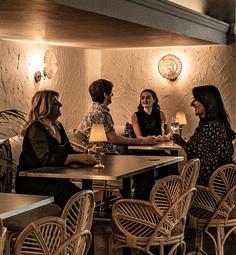

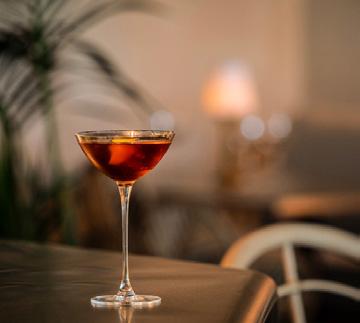

Opening hours Wed-Thurs 4pm-11pm, Friday 12pm-12am, Saturday 10am-12am, Sunday 10am-5.30pm. doylecollection.com/hotels/the-bristol-hotel/dining/ricks

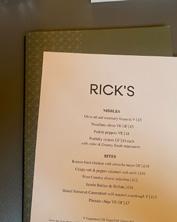

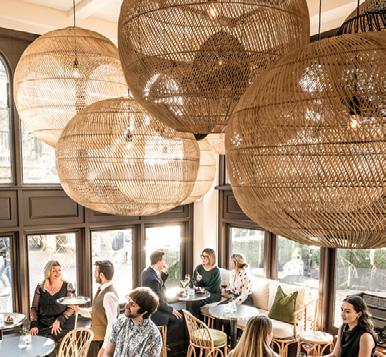

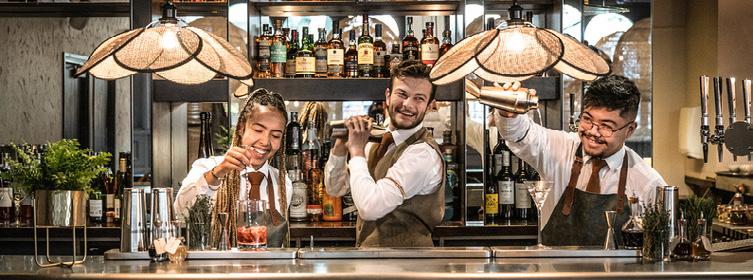
28 29
Events & Happenings
Step out of your hotel and into our pick of this month’s most captivating events
The Bloomsbury
A
HIDDEN CENTURY
Between 1796 and 1912 the very fabric of China changed – as a series of civil uprisings, foreign wars and, ultimately, revolution brought an end to two Millennia of dynastic rule and all-powerful emperors gave way to a new political order, the modern Chinese Republic. In this groundbreaking exhibition, the British Museum celebrates the creativity that accompanied all the upheaval, gathering together exquisite objects that mark the changes.
China’s Hidden Century
The British Museum 18th May – 8th October britishmuseum.org
HAVING A MELTDOWN
At 28 years old, Southbank’s Meltdown is the longest running artist-authored festival in the UK. Previously curated by a roster of greats from Elvis Costello to David Bowie, Yoko

Ono to Patti Smith, in 2023
Christine and the Queens are taking on the challenge and with his dance background, immersive music and general French genius, expectations are extremely high. There’s a programme. We recommend.
Christine and the Queens’ Meltdown
Southbank Centre
9th – 18th June southbankcentre.co.uk
QUEEN OF FLAMENCO
There’s always something to see at Sadler’s Wells theatre, but this summer’s Festival
of Flamenco is a real treat, with Flamenco Queen Sara Baras, Manuel Liñán, El Yiyo, Alfonso Losa and Carrete de Malaga leading and shaping this festival of fire, passion and absolute control that infuses the movement, music and imagination that fuel this dramatic dance form.
Flamenco Festival
Sadlers Wells Theatre, Angel 5th – 15th July sadlerswells.com
SOUNDTRACK TO SUMMER
There’s something rather wonderful about the acoustics of a stone courtyard and the festival spirit conjured by Somerset House’s summer
series makes the space feel otherworldly. And hard to believe you can get this close to a stellar roster of artists, from Gabriels to Alison Goldfrapp, Interpol to Young Fathers in the heart of the city.
Summer Series with American Express Somerset House 6th – 16th July somersethouse.org.uk
The Kensington
TITANOSAURUS, WE PRESUME
The clue’s in the name - it’s an absolute giant among dinosaurs. The Natural
better destination than Holland Park in London’s leafy borough of Kensington & Chelsea. An arts charity with an impressive outreach programme, Holland Park Opera is a unique destination for a finely honed programme from Holst to Humperdinck, Verdi to Dove, with London Sinfonia as orchestra in residence, in beautiful surroundings.
Opera Holland Park Holland Park 30th May -12th August operahollandpark.com
BLOOMING MARVELLOUS
The relaxed country cousin to Chelsea Flower Show’s metropolitan spectacle, the Hampton Court Flower Festival is all rose marquees, pruning masterclasses, food and fizz and is set in the beautiful Thameside gardens and water meadows of Hampton Court Palace. In 2023 the festival celebrates sustainable floristry, championing independent growers over the epic hothouses supplying the cut flower industry.
LIKE A DIVA
Once defined by the Wall Street Journal as ‘high maintenance narcissists’ (such tales as Mariah Carey’s
‘staircase assistant’ abound), the word ‘Diva’ is actually Italian for ‘goddess’ and the V&A is celebrating some of the most fabulous icons of stage
and screen (Cher to Grace Jones, Marilyn to Lizzo, you get the picture) sharing stories of ambition, resilience and using their platform for good.
DIVA
V&A South Kensington 24th June 2023 –7th April 2024 vam.ac.uk
The Marylebone
ALL THE WORLD’S A STAGE
Seating up to 1,240 and wonderfully atmospheric for being outdoors, the mature tree-flanked wooden boards of the Regent’s Park Open Air Theatre have been trodden by some of the world’s most garlanded actors (Judi Dench to Benedict Cumberbatch, Richard E Grant to Sheridan Smith) in a serially award-winning, diverse programme from Shakespeare to musicals, with something for all ages.
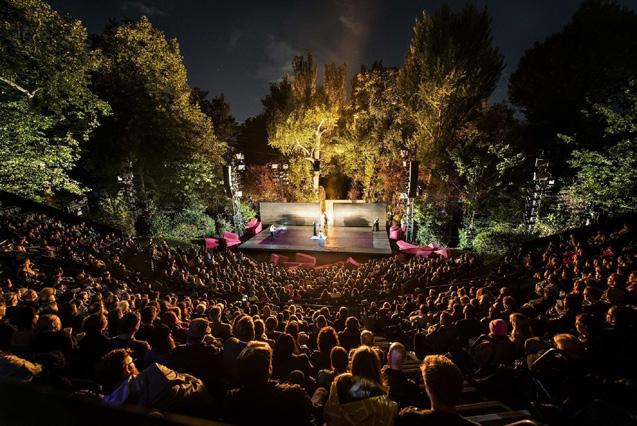
Open Air Theatre, Regent’s Park 10th May – 16th September openairtheatre.com
History Museum is thrilled
to be the first in Europe to exhibit Patagotitan mayorum (the giant dino of Patagonia, excavated in 2014). Or at least a meticulous cast of its bones. It’s 37 metres long and eight metres high and, being a cast, it looks super-realistic – but is robust enough to touch… Titanosaur. Life as the biggest dinosaur.
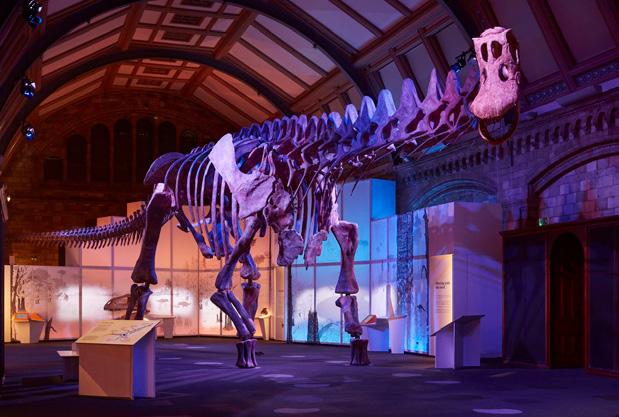
Natural History Museum
31st March 20237th January 2024 nhm.ac.uk
IN FULL VOICE
For those preferring their opera (and ballet) in a more metropolitan setting what
Hampton Court Flower Festival Hampton Court Palace, Surrey 4th – 9th July rhs.org.uk
Top left The biggest dinosaur in the world is revealed at the Natural History Museum.
Top The story of the diva at the V&A museum.
Right Open air theatre rain or shine in Regent’s Park.
30
DAWNING OF A NEW ERA
Londoners and tourists alike have missed the National Portrait Gallery like an old friend during its three-year (really!) closure for a £35.5m redevelopment to create a destination that’s ‘fit for 21st century audiences’, ‘of people and for people, telling Britain’s story through portraits’. We’re just dying to see what they’ve done to the place (and the opening exhibition of Paul McCartney’s previously unseen photographs).
National Portrait Gallery
22nd June 2023 npg.org.uk
TWO PEOPLE, ONE ARTIST
An East End institution, with their toning tweed suits, serious expressions, NSFW subject matter and global success, Gilbert & George have been eccentric fixtures of the British Art Scene for over half a century. Their latest venture is focused on legacy, realising their slogan ‘art is for all’ in a newly opened Gilbert & George Centre that showcases their work, is free to enter, and welcomes everyone.
The Gilbert & George Centre Heneage Street, London E1
Open Friday to Sunday weekly. gilbertandgeorgecentre.org
Bristol
PRIDE AND VISION
As part of Bristol Pride celebrations (check out the rest too), the Queer Vision Film Festival celebrates its 10th anniversary with a diverse programme of features, documentaries, shorts and animation all chosen in line with the organisers’ mission to make everybody in the
LGBTQ+ Community feel seen and celebrated. Also, there’s some cracking movies on the schedule, so go.
Pride and Vision
10th – 13th August
bristolballoonfiesta.co.uk
THAT’S COMEDY
The Watershed 24th June – 9th July bristolpride.co.uk/queervision
LOOKING UP
Gaze up into the sunset this August and you’ll see over 100 hot air balloons lighting up the night sky. So far so fabulous. But if you head to Ashton Court Estate (it’s easy) you’ll see (for free) the balloons in all their glory, along with aerial displays, entertainments, a fairground and food stalls. Then, to sounds from Radio Bristol, watch the balloons rise into the skies.
Bristol International Balloon Fiesta
Ashton Court Estate, Long Ashton
It’s the west country’s biggest comedy festival, set in a big top in Queens Square, and featuring a stellar line up including Jack Dee, Dylan Moran, Sara Pascoe, Ed Gamble, Bridget Christie, Sophie Duker, Tim Key, Rachel Parris, Phil Wang and many, many more in four days of serious lolz. Street food and bars provide the obligatory sustenance between acts.
Bristol Comedy Garden
Queen’s Square
14th – 18th June
bristolcomedygarden.co.uk
RAINBOWS AND UNICORNS
Well, we can’t promise rainbows, but unicorn fest really is a thing, a magical trail around Bristol landmarks featuring 60
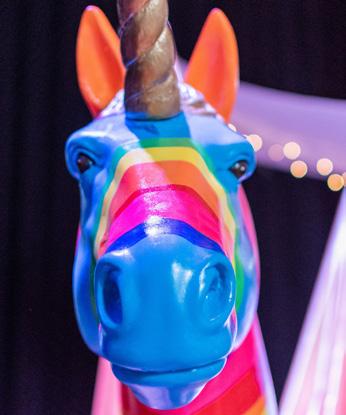
mythical creatures, each one painted to a design submitted by a Bristol Artist (chosen from over 200 submissions), along with foals (yes, baby unicorns) in a fundraiser for Leukemia Care. Maps are digital (download the app) and follow the trail all over Bristol and the Southwest.
Unicornfest
All over Bristol (check the map)
From 3rd July theunicornfest.co.uk
The Westbury
SCENE OF THE MYTH
New York-born, Dublinbased artist, Sarah Pierce, is bringing her extraordinary new retrospective, Scene of the Myth, curated by long-time collaborator Rike Frank and the European Kunsthalle to the Irish Museum of Modern Art (IMMA). Pierce’s interest is primarily in narrative and the media she selects includes installation, performance, talks, papers and archives, all used to ‘challenge received histories and forms of making’. It’ll be memorable.
Scene of the Myth 24th March – 3rd September imma.ie
TONIGHT, TONIGHT
Young love, heat, drama, soaring songs (Leonard Bernstein, you know), hot rhythms, tragedy – it must be West Side Story. As a new production created and directed by New York legend Lonny Price with an international creative team comes to Dublin on its world tour to bring all the passion of the Upper West Side original to the Bord Gáis.
West Side Story
Bord Gáis Energy Theatre
12th – 24th June bordgaisenergytheatre.ie
THE BLOOMSDAY SCENARIO
James Joyce very sensibly set his modernist masterpiece, the epic novel Ulysses, over just one day (16th June 1904), making it the perfect moment for future fans that wished to celebrate his work and life over a century on. And celebrate it and protagonist Leopold Bloom they do, all over Dublin, with readings, performances and visits to places in the novel, often dressed in period costume.
BLOOMSDAY
All over Dublin 16th June bloomsdayfestival.ie

GIRL ON AN ALTAR
This majestic piece of theatre is a tale of marital derailment, eternal attraction, love, desire, hate, resentment and familial drama, by garlanded Irish playwright, Marina Carr, inspired by Agamemnon, and originally staged in 2022 in the Kiln Theatre, London to much critical acclaim. This production at The Abbey, Ireland’s National theatre, stars the original principles in
an evening of raw intensity. Girl on an Altar Abbey Theatre 8th July - 19th August abbeytheatre.ie
The Croke Park
ROAR OF THE CROWD
‘Croker’ seems a modest nickname for the theatre of
sports that showcases the pinnacle of Gaelic Game action - and happens to be set in The Croke Park’s backyard. There’s something a little Narnia-
Left Painted unicorns. abound in Bristol to raise funds for Leukemia Care. Right, top Expertly re-branded, London’s National Portrait Gallery. re-opens to great acclaim. Right Celebrate Bloomsday and everything James Joyce all over Dublin.

esque about the proximity, and entirely magical about every matchday - whether Gaelic football or hurling is your sport of choice, the very best in the business will be leaving their hearts on the pitch.
Match Day at Croke Park Croke Park Stadium
All summer, check for dates crokepark.ie/matchday
HOUSE OF FUN
It’s not often a musical based on a graphic novel wins five Tonys, two Obies, three Lucille Lortels, an Outer Critics Circle Award and is a finalist in the Pullitzer Prize for Drama. But Fun House achieve all that and, most importantly, won the
32 33
hearts of audiences all over. This new production, directed by Róisín McBrinn leads The Gate theatre’s summer programme.
Fun House
Gate Theatre
6th July – 25th August gatetheatre.ie
GRILL TO THE BONE
Back to Ballsbridge (south of Dublin) we go for the Big Grill Festival, Europe’s biggest BBQ and grill festival where over 50 chefs will be smoking, grilling, flaming and serving up some of the best barbeque on the planet with cooking demos, tastings, chilli eating contests and a great programme of music, too. With something for everyone, it’s a proper family affair.
The Big Grill
Herbert Park Ballsbridge
17th – 20th August biggrillfestival.com
HORSES FOR COURSES
The premier Irish show jumping event of the year and, naturally,
an opportunity to dress up to the nines, see and be seen, the Dublin Horse Show is the fixture for the horsey set and, indeed, anybody that
would be thrilled to watch some of the best jumpers and equestrians on earth rising to a magnificent occasion. It’s south of Dublin but there’s
transport options aplenty.
Dublin Horse Show
RDS Arena Ballsbridge
9th – 13th August dublinhorseshow.com
The Dupont Circle
TAKE PRIDE
DC’s Capital Pride Alliance really pushes the floats out for the annual pride parade, plus a mind-blowing week of pool parties, block parties, dance parties, concerts, parades, festivals, awards and all the fabulous things you’d expect from Pride week in the capital. Check out what’s happening and dust down your stamina for some dawn-to-dawn party times.
Capital Pride Celebrations 3rd – 12th June capitalpride.org
MAKING HISTORY
1776 marked the signing of the Declaration of American Independence. So, back in the 1960s, Sherman Edwards and Peter Stone wrote a musical about it telling the tale of paused personal objectives
for the common good, and winning three Tonys in its first run. Themes explored again in this production from Harvard’s American Repertory Theatre and Chicago’s Roundabout Theatre Company by a cast united in diversity of ethnicity, race and gender.
1776
Eisenhower Theatre 27th June – 16th July kennedy-center.org
FESTIVAL 101
The National Mall comes alive every summer with DC’s Smithsonian Folklife festival, a free international cultural festival presenting a fortnight of stellar performances, thought-provoking events, immersive experiences, crafts, workshops, singalongs and, of course, fabulous food, drink and artisan markets. Part cultural exchange, part learning experience, part family fun day out, it’s not to be missed.
Smithsonian Folklife Festival National Mall 29th June – 9th July festival.si.edu
LET IT GO!
The River Lee
HAPPY DAYS
Siobhán McSweeney is probably the only actress we’d happily go and watch on stage,
Above Float your messages at The Water Lantern Festival in Washington DC.
Left Europe’s biggest barbecue and grill festival takes place in Herbert Park, Dublin.

Right Siobhán McSweeney in a magnificent revival of Happy Days at Cork Opera House.
Every felt the urge to write down your hopes and dreams, the things you wish to let go, or even a letter you’ll never be able to send – then release it all into the wild, sending wishes into the universe (ideally for granting), or letting all negativity lift away. Then get yourself to the DC Water Lantern Festival (it’s all over the States), create your paper lantern, light a candle, make your peace and watch it float away in a twinkling of lights.
Water Lantern Festival DC National Harbor SouthPointe 5th August waterlanternfestival.com/ washington-dc.php

buried in a mound of earth, pondering her predicament while the sun beats pitilessly upon her. Joking aside, this play is a Samuel Beckett masterpiece and Cork native McSweeny won rave reviews when her original outing as Winnie broadcast live from the Olympia in 2021. Directed by Caitriona McLaughlin, this is not to be missed.

Happy Days by Samuel Beckett.
Cork Opera House 14th – 17th June corkoperahouse.ie
IT’S A CORKER
A ten day arts festival set all over the place in Cork, city of gourmets, artisans and artists.
In venues of all sizes and all over town, from the Cork Opera House (including the aforementioned Happy Days) to small studios and featuring music, theatre, installations and talks, arts festivals and midsummer don’t come much better than this.
Cork Midsummer Festival
All over town 14th-23rd June corkmidsummer.com
CORK ON A FORK
Five days of feasting and fun, following food trails, marvelling at masterclasses, watching food alchemists on the live stage, enjoying cookery demonstrations, listening to talks, tucking into tastings and discovering the very best of Cork’s legendary produce including street food accompanied by music (jazz mainly) and song (it’s opera!),
Cork is definitely the place to be this August.
Cork on a Fork
All over town 16th-20th August corkcity.ie
AND
NOW FOR SOMETHING COMPLETELY DIFFERENT
Produced by Miss Emerald Elle (Pinup Model) and Cork-born international burlesque artiste, FiFi La Roux (The Burlesque Clown with a liberal sprinkling of biodegradable glitter), The Cork Burlesque festival is a celebration of all things fabulous, with Headliner Competition, Rebel Cabaret and spectacular Gala. With a lineup that includes some of the best burlesque artistes from around the world it’s all the better for having been bumped from 2020.
Cork Burlesque Festival
Cork Arts Theatre 24th – 26th August corkburlesquefestival.com
35
24 HOURS
A GREAT (COUNTRY) GARDEN ESCAPE
The Marylebone may technically be in a village but there are times when we all need a proper break from the hurly burly. Time for an escape to the country.
7.15 ARISE & SHOWER
That snooze button won’t stop itself, it’s time to rise. doylecollection.com/hotels/the-marylebone-hotel
8.10 RIDE & DINE
Taxi to Paddington, meet, greet, then board the train to Castle Cary in Somerset before breakfast in the First Class dining room. What to order?
10.50 NEWT SWEET!
You’ve arrived at The Newt, a fine Georgian honeycoloured limestone manor set amidst Somerset woodland, manicured lawns, lakes, ponds and appleladen orchards.
10.55 GARDEN HO!
200 years in the making, these gardens are the work of generations of experts, beautifully arranged around the walled parabola. Wander the gardens, the grotto, the woodlands and the deer park, and look out for native wildlife.
12.15 LUNCH IS SERVED
In the garden café, one of several fine eateries, serving produce that’s home grown or sourced nearby.
13.30 TIME TO WANDER
Take in the garden exhibition, explore the Roman Villa Experience, discover the buzzing hives and the keepers of Beezantium, ascend the aerial walk through the elegant boughs of noble ash, and take in the Newt’s exceedingly well-stocked shop…
14.45 CYDER HOUR
It’s Somerset’s native drink, watch the Newt’s fine apples being pressed and bottled before sampling, draining your glass and murmuring, like a local, ‘that’s the badger’.
16.02 CARRIAGES & TEA
Your train eases out of Castle Cary and your only worry is how you’re going to fit in the delicious afternoon tea now being served in the buffet car.
18.00 AND, UNWIND
Back at The Marylebone we recommend a long bath followed by a trip to The Cocktail Bar to try a drink from our new ‘Seasons’ menu with a light bite before bed. thenewtinsomerset.com/great-garden-escape
THEN
Who knew a brief visit in 1923 by a former YWCA (Young Women’s Christian Association) General Secretary to London from Australia would birth an architectural icon? Yet such was the origin story for the YWCA Central Club – today The Bloomsbury. Finding no YWCA branch in which to safely stay, the official started a campaign to change all that. Slogans like ‘Be a
& NOW
From a seated lobby for YWCA guests to a brightly painted bar, The Coral Room has evolved Sir Edwin Lutyens’ original vision for ‘an austere and materially rich’ building that’s ‘bold and beautiful without ostentation’. Today, there’s little that’s austere about the interior, but The Bloomsbury team have over time upped the ‘material richness’, with walls lacquered in a deep, warm coral, chandeliers


brick and buy a brick’ and ‘London, stand by your girls’ may not have much of a ring to them today but in the ‘20s they raised the kind of money that could build a structure like Lutyens’ London landmark. The first stone was laid (by Queen Mary no less) in 1929, and the building completed just two years’ later, ready for occupation by women and girls from all over the world.
that conjure a sense of pared back glamour, shiny woods and highly polished marble, deep, soft, velvety upholstery and a dramatic mirrored back-lit bar. One thing that hasn’t changed is the way the room brings people from all over the world together, to talk, exchange ideas, relax, revitalise and, of course, savour the unparalleled expertise of The Coral Room’s wonderful cocktail makers and shakers.
THE CORAL ROOM BAR, TODAY
36
YWCA CENTRAL CLUB ENTRANCE C. 1990




 Explore our portfolio of Irish family-owned luxury hotels superbly located in the centre of London, Dublin, Bristol, Washington DC and Cork
Explore our portfolio of Irish family-owned luxury hotels superbly located in the centre of London, Dublin, Bristol, Washington DC and Cork









































































